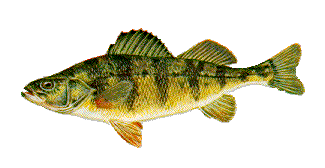
Yellow Perch
( Perca flavescens )

Yellow Perch
( Perca flavescens )
Their golden-yellow bodies draped with 6 to 9 dark vertical bars and their lower fins fading from amber to a brilliant orange, the yellow perch is probably one of the most popular and more colorful members of the perch family. The males are much more brightly colored than the females, especially during the spawning run which usually occurs in the early Spring at night, or very early in the morning when the waters warm to 43ø to 48øF. Sometimes nicknamed raccoon perch, ringed perch, or redfin perch, the yellow perch is one of the few native fish of Lake Hopatcong. A true member of the perch family (Percidae) which consists of three major groups, the pike-perch, the yellow perch and the darters. The pike-perch group includes the larger walleyes and saugers which are the largest members of this family. All members of the perch family of fish have long cylindrical shaped bodies with two distinct dorsal fins. The yellow perch can easily be distinguished from their walleye and the sauger cousins by their lack of very sharp conical fang like teeth. Those of us who were able to help stock the walleyes know that even the 5 to 7 inch walleye fingerlings are fully equipped with a complete aray of very sharp dental work. The darters include more than 100 species and they are all in a size class to small to be caught on a hook and line by fishermen. Yellow perch are considered to be a cool water fish. They require cold water temperatures during several months of the year for their reproductive organs to mature. In addition to being an important forage fish in the food chain, the yellow perch is a very co-operative biter, and can usually be caught year-round. A favorite quarry of the ice fishermen, their firm, white flaky meat can sometimes be tastier than that of the walleye. Biologist Pat Hamilton collected several yellow perch from five different year classes during her lake survey of 1995. There seems to be a highly variable growth rate in the yellow perch species. The one year-old fish were 2.9 to 4.9 inches in length, the two year-olds were 5.7 to 7.7 inches long, the three year-olds were 6.7 to 9.0 inches long, the four year-olds were 7.2 to 9.3 inches long and the five year-olds were 8.4 to 12.7 inches long. The yellow perch sampled were captured during July and August. Our senior historical club record of 2 pounds 13 ounces was caught by my old friend Elvio Zamuner back in 1973, while the historical junior record of 2 pounds 1 ounce was caught by Sean Auriemma in 1974. Our current Club Record of 1 pound 13 ounces was caught by Ed Murray in the year of 1990 and Junior Member Chris Lofton was right behind him with a 1 pound 12 ounce entry caught in 1991. The State of New Jersey also has a historical record for this species, over 100 years ago , back in 1865 Charles Abbott caught a real LUNKER weighing 4 pounds 4 ounces from Crosswicks Creek on the Delaware River and still stands as a World Record to date. The more current State Record of 2 pounds 6 ounces was caught from Holiday Lake by Gene Engels back in 1989. Our 1997 1 Place winner was Joe DeStefano with a 1 pound 8 ounce entry and Junior Member Bill Mayfield took 1 Place with his 1 pound 5 ounce entry.
This fish was introduced into Lake Hopatcong back in 1895 by then Fish & Game Commissioner Howard Frothingham. Actually the white perch is not a perch, but a member of the Temperate Bass family (Percichthyidae) which also includes the White Bass, the Yellow Bass and the larger Striped Bass. All members of the Temperate Bass family have two dorsal fins, numerous very small teeth and one or two very sharp spines at the rear edge of their gill cover. The White Perch lacks the horizontal stripes that are present on the other members of this family and its tail is narrow than that of the larger White Bass. The deepest part of the body of a White Perch is just in front of the dorsal fin, while the deepest part of the body of a White Bass is closer to the middle of its back. They spawn in the Spring when the water warms to be 50ø to 60øF. They migrate up tributary streams and randomly deposit their eggs over gravel shoals or sparse vegetation. This fish is very slow growing, but can be long lived, capable of reaching a maximum age of 17 years. The World Record of 4 pounds 12 ounces was caught in Maine in 1949. The State Record 3 pounds 1 ounce was caught in 1989 by Edward Tango in Forest Hill Lake and has also been certified by the IGFA as a world record and W. Fliegauf's Historical Record Lake Hopatcong "LUNKER" of 2 pounds 15 ounces was caught back in 1952. Our current KNEE DEEP CLUB Membership Chairman, Eric Leef #6024 was our 1997 1st Place Winner with a 1 pound 11 ounce fish that taped 14-1/2 inches. Several White Perch were sampled during Pat Hamilton's lake survey in 1995. The two year old fish averaged 5.7 inches, five year olds averaged 9.4 inches, eight year-olds were 11.4 inches and one ten year old fish was 12.7 inches long. Based on the findings of the fish surveyed, I would have to guess that Eric's 14-1/2 inch fish was probably in the 14 year old "Senior Citizen" class of 1983. Their firm white meat is excellent eating but can spoil quickly if not kept chilled. All members of the Temperate Bass family being kept for consumption should immediately be placed in a cooler and iced down. Much to my surprise, there were no White Perch entries in our Junior Division during 1997.